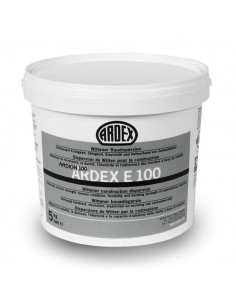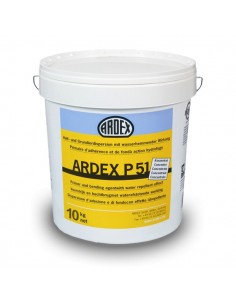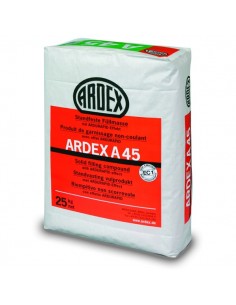Field of application:
Rapid cementitious screed for making cement screeds. ARDEX A35, a special cement improved with synthetic resins, can be mixed with sands with a grain size of 0 to 8 mm and water to obtain a plastic mortar with a moisture content and consistency of dry sand.
Screeds with ARDEX A35 cement can be walked on after 3 hours. On plastic spacer, they become floating and ready to receive the final floor covering after 24 hours and meet the minimum required standards in accordance with DIN 18560. The standards DIN 18560 and DIN 18353 are valid for the realisation of cementitious screeds, also floating on an integrated release film.
Indoors.
Application on underfloor heating: When screeds with ARDEX A35 are laid on underfloor heating with hot water, the waiting time before application of the screed should be less than 15 days. The screed made with ARDEX A35 cement will have reached its equilibrium moisture content after 24 hours. We can start heating 3 days later, starting with a temperature of 25°C and maintain it for 3 days.
The temperature should then be adjusted to maximum and maintained for 4 days. During this time it is advisable to avoid draughts. The surface temperature should not drop below 1 5°C during the laying of the screed.
Screeds made with ARDEX A35 can be heated up to 65°C.
Instructions for use:
To mix the mortar, use a mixer of approx. 100-125 litres.
Mixing ratio:
25 kg ARDEX A35=1 bag.
100-125 kg of 0-8 mm sand = 15-19 shovelfuls.
6 to 11 litres of water depending on the moisture content of the sand.
The mixers and pumping machines are ideal for the production of rapid screeds.
The quantities required for a 220 litre load are:
50 Kg of ARDEX A35=2 bags.
200-250 kg of 0-8 mm sand = 30-38 shovelfuls.
12-22 litres of water depending on the humidity of the sand.
The screed will be workable and can be screeded after 24 hours if the water dosages and aggregate mix specified here are followed correctly.
The total amount of water, i.e. mixing water and sand, should not exceed 11 litres and 22 litres respectively for each mortar mix.
Do not use additives or mixing oils. Do not mix with other types of cements. The working time of ARDEX A35 mortar is approximately 1 hour. Mixing, application, levelling and smoothing must be carried out successively.
The surfaces to be made should be large enough to allow all the processes to be carried out within the established time, bearing in mind that high temperatures shorten the time and conversely low temperatures lengthen the workability time.
To make screeds adhered to other screeds, apply a primer of ARDEX P51 or ARDEX E100 on the concrete substrate, then, on top of the fresh primer, apply the barbotine, which is made by mixing ARDEX A35 with sand (0-4 mm) in the proportion of 1:1 and adding a 1:1 ratio of ARDEX A35 and ARDEX E100 to the primer, then apply a 1:1 ratio of ARDEX A35 and ARDEX E100.
1 : 1 and adding 1 part water and 1 part ARDEX P51 or ARDEX E100.
The barbotine must be applied fresh on fresh, with the substrate well swept. Apply the ARDEX A35 screed on top of the still wet barbotine. If in doubt, make a small patch.
Do not use ARDEX A35 at temperatures below 5°C.
Aggregate mixing:
The correct aggregate mix for ARDEX A35 and ARDEX EB2 cements is:
|
11% |
31% |
15% |
17% |
26% |
|
0,00- 0,25 mm |
0,25 - 1,00 mm |
1,00- 2,00 mm |
2,00- |
4,00- |
The best aggregates are "river washed sand" and spherical shaped aggregates (cubic or polyhedral pebbles and crushed stone) because the water/cement ratio is lower and higher strengths are obtained.
After 3 hours, a screed made with ARDEX A35 can be covered with ARDEX K55 self-levelling mortar or ceramic tiles and natural stone can be laid.
After 24 hours and with a residual moisture content of 2-3%, any type of work can be carried out and any cladding can be laid on top of it.
Important:
ARDEX A35 screeds on insulating or separating layer, regardless of the compression of this layer, must have a minimum thickness of 40 mm avoiding that the moving loads do not exceed 1.5 KN/m2 per room and these must be well distributed.
ARDEX A35 is not usable outdoors and also not in places with constant humidity.
Precautions:
This product contains cement.
Alkaline reaction. Protect skin and eyes. In case of contact, clean with plenty of water. In case of contact with eyes, consult a doctor.
After drying, the product is physiologically and ecologically neutral.
Giscode ZP1 = product based on chromate-poor cement.
Technical data
-Mixing ratio: Mixing ratio 1:4 (by weight)
25 kg. ARDEX A35 (1 bag) 100 kg. sand 0-8 mm. granulometry.
6-11 liters of water (according to humidity of the sand).
-Mixing ratio 1:5 (by weight)
25 kg. of ARDEX A35 (1 bag) 125 kg. sand 0-8 mm. granulometry.
6-11 liters of water (according to humidity of the sand) -Density of the mortar in water (in weight)
-Density of the mortar when fresh: 2 kg/liter approx.
-Yield:
3.7 kg. of powder per m2 and cm. of thickness (in mixture 1:4).
3.1 kg. of powder per m2 and cm of thickness (in 1:5 mix) -Workability time (1:5)
-Workability time (20°C):
-Approx. 1 hour Compressive strength:
-At 1:4 ratio.
Approx. 25 N/mm2 (1day)
Approx. 35 N/mm2 (3 days)
Approx. 45 N/mm2 (28days)
-In the ratio 1:5
Approx. 20 N/mm2 (1 day)
Approx. 30 N/mm2 (3 days)
Approx. 35 N/mm2 (28days)
-Flexural strength:
-In the ratio 1:4
Approx. 5 N/mm2 (1 day)
Approx. 6 N/mm2 (3 days)
Approx. 7 N/mm2 (28days)
-In the ratio 1:5
Approx. 4 N/mm2 (1day)
Approx. 5 N/mm2 (3 days)
Approx. 6 N/mm2 (28days)
-Residual moisture:
Floating screed on separating layer: 2-3% of mass (24 h). Slightly more than 1-2% of latent water can be detected with the CM apparatus.
-Corrosion: None.
-Suitable for radiant heating: Yes
-Packaging: 25 kg bags.
-Storage: Approx. 12 months in dry places and in its original closed container.









